We may be able to freeze embryos, but challenges remain for larger organs. Hayley Bennett talks to the scientists trying to push the boundaries of cryopreservation
-
Cryoprotectants and vitrification: Cryopreservation relies on cryoprotectants like glycerol and DMSO to prevent ice formation inside cells. Vitrification, a rapid cooling technique, turns water into a glass-like solid, reducing ice damage but requiring high concentrations of cryoprotectants, which can be toxic.
-
Challenges with larger organs: Freezing and safely thawing larger tissues and organs is difficult due to uneven heat transfer, which can cause ice crystals to form and damage cells. Innovations like nanowarming, which uses nanoparticles to heat organs from the inside out, show promise in overcoming these challenges.
-
Toxicity and new cryoprotectants: Traditional cryoprotectants like DMSO are effective but toxic. Researchers are developing new, less toxic cryoprotectants, such as polyampholytes, which prevent excessive dehydration and ice damage without penetrating cell membranes.
-
Future prospects: While significant progress has been made, especially in fertility treatments, cryopreservation of larger organs for transplantation remains challenging. Advances in cooling and warming techniques, as well as new cryoprotectants, are essential for future breakthroughs.
This summary was generated by AI and checked by a human editor
Scientists have long been fascinated by the idea of cooling cells or tissues as a way of suspending life. The 18th-century Italian priest and biologist Lazzaro Spallanzani experimented with sperm and snow. ‘He used the relatively modern – at the time – microscope and put sperm on snow, watched them slow down and then, when the snow melted, watched them swim again,’ says cryopreservation expert James Benson from the University of Saskatchewan in Canada.
In 1780, Spallanzani became a pioneer in the field of artificial insemination, when he impregnated a dog by injecting it with sperm. Back then, of course, he didn’t have the benefit of modern cryogenic techniques used in fertility treatment, such as sperm freezing – he didn’t even have a freezer – and it would be many more years before even single cells like sperm could be reliably frozen.
Eventually, the canny use of chemical concoctions containing ‘cryoprotectants’ enabled life to survive indefinitely in sub-zero. Researchers across the life sciences were able to bank and ship the cells they used in their studies, develop regenerative treatments for diseases like cancer based on stem cells and even preserve the tissues of endangered animals for the future. But experts have still to fully solve the problems they meet with when trying to put life on ice – problems with how and where ice forms, the toxicity of the chemicals they have to use to stop it, and heating everything back up again safely. Until now, these problems have kept long-anticipated applications like organ banking out of reach, although solutions may be on the horizon.
‘Progress has been sort of … significant, but inching up the hill, as it were,’ says Barry Fuller, a cryopreservation expert at University College London in the UK, who describes cryopreservation as ‘like sending some cells to the dark side of the Moon’ and expecting them to come back alive. What makes it so tricky to freeze – and safely unfreeze – living cells, how far has the science of cryopreservation come and where could it yet take us?
Deathly cold
The central problem of cryopreservation is ice. Ice crystals cause damage that can be lethal for cells. So what cryo experts usually try to do is dehydrate their cells, using chemical cryoprotectants, to stop ice forming on the inside. As Benson explains, this dehydration is driven by ice crystals forming on the outside: as liquid water outside a cell becomes increasingly bound up in ice, the cell becomes bathed in a gradually more concentrated solution, which draws water from the inside to help reset the balance. But if cooling happens faster than the cell can drain itself, then too much water gets left behind and the cell risks death by ‘inside ice’. For much of the last century, the cryopreservation game has been about manipulating concentration and timing of cooling, to make sure the water is pulled out of the cell before it freezes.
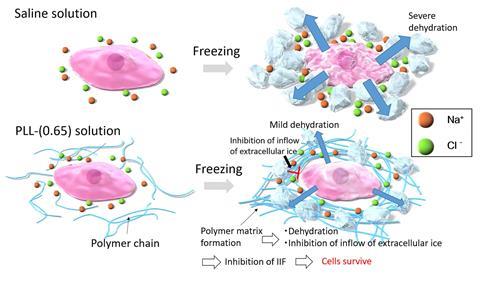
In the early 20th century, however, freezing enthusiasts didn’t have cryoprotectants to help them dehydrate cells. They worked with so-called ‘slam’ or rapid freezing techniques, cooling cells in their natural medium: salts, which, at high concentrations, denature proteins and destroy cell membranes. But a chance discovery reported in 1949 revealed that the salts could be swapped for less destructive solutes – and ones that helped delay water freezing. Someone in Alan Parkes’s team at the National Institute for Medical Research in London mislabelled a solution intended for mounting microscope slides and it ended up mixed into some sperm samples. When the sperm survived freezing at –79ºC, the team rushed to analyse the contents of the mystery solution, revealing glycerol as the key ingredient.
Glycerol became the standard in freezing of bull’s sperm for artificial insemination techniques used in farming. But, according to Benson, Parkes’s discovery also kick-started ‘the modern era of trying to understand what cryoprotectants do to protect the cells during slow cooling’. Other cryoprotectants followed, including in 1959 the more powerful dimethyl sulfoxide (DMSO), which is still widely used today. DMSO is thought to interfere with ice crystal formation, in part, by hydrogen bonding with water molecules, and may also open pores in cells’ external membranes to help dehydrate them. Later, in the 1960s, natural cryoprotectants dubbed ‘antifreeze proteins’ were discovered in Antarctic fish and cryo-experts have since devoted a lot of energy to trying to make synthetic versions of them. Natural or synthetic, many of the molecules in question are ice-modifiers that enable animals, and scientists, to control how ice forms.
Having ditched fast cooling for slow cooling, cryobiologists did an about-turn of sorts in the 1980s, when they adopted vitrification – a process using such rapid cooling that it turns water straight from a liquid to a disordered glass-like solid, before its molecules have time to order themselves into ice. Rather than cells being dehydrated slowly during the cooling period, they are dehydrated beforehand using very high concentrations of cryoprotectants. Although such high concentrations came with toxicity concerns, vitrification was initially seen as a way to solve the problem of freezing larger tissues, including organs. It soon became clear that it wouldn’t be that easy, but the technique was widely embraced by the fertility industry.
Fuller lived through the transition from slow cooling to vitrification in reproductive biology and explains that vitrification of human eggs or embryos is practically more difficult, requiring a higher level of skill. ‘I grew up with traditional slow cooling, which used a cooling machine that was able to be used by people with reasonable training,’ he recalls. ‘Whereas vitrification is fast, but it requires dedicated, expert staff.’ The real headline, however, was that vitrification caused less damage and was able to help push up success rates for fertility treatments. Though there have been suggestions in recent years that the high concentrations of cryoprotectants required to get to glass may cause epigenetic changes to DNA – these changes, which include chemical modifications, may alter gene activity in embryos, even if they don’t affect the base code itself.
Size does matter
While fertility specialists have seen great success with vitrification, the same can’t be said for those in the transplant field, who have struggled to bring organs back safely from the depths of cold storage due to issues with transferring heat evenly across larger tissues. Hopes were initially raised in 1984, when a team led by Greg Fahy at the American Red Cross reported vitrifying rabbit kidneys. But things inevitably went wrong when Fahy’s team tried to warm the organs back up; they managed one transplant but could never repeat it. On the other hand, Fahy was able to vitrify and rewarm embryos thanks to their small size.
Back then, John Bischof, now at the University of Minnesota in the US, was just embarking on a career in cryopreservation, working with the late cryo-legend David Pegg. Rather than completely vitrifying organs, Pegg’s team was trying to compete with Fahy’s by doing a partial freezing approach. It didn’t work, but according to Bischof, there was a very real sense that success was imminent. ‘We would go out to lunch or interact socially and it was clear that he thought he was close to being the first person to actually cryopreserve an organ,’ he says. ‘And it didn’t ever happen.’
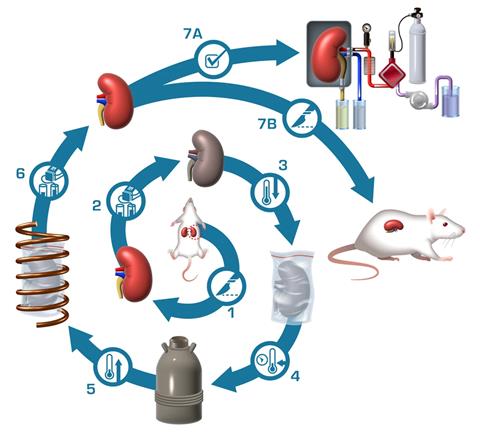
The problem is that even cells that are vitrified contain very tiny amounts of ice. And as they’re heated back up, these ice ‘seeds’ begin to grow. Bigger systems, like organs, pose more of a challenge because it’s much harder to get everything heated up quickly and evenly – the ice seeds spend more time in the danger zone where larger ice crystals can form. So whilst cryopreservation may be seen as a cooling problem, it’s actually more accurate to think of it as a cooling and warming problem. Bringing cells safely through vitrification is a bit like trying to drive a car through a hedge and then reverse it back out without scratching it – the risk of damage occurs in both directions.
But last year, Bischof’s team made a breakthrough that Fuller calls a ‘significant in-road’ into the rewarming problem. Working with rat kidneys, they vitrified the organs and stored them for three months at –150ºC. Then, instead of warming them in the conventional way, they heated them up from the inside out. They had previously loaded the blood vessels with nanoparticles that effectively turn an organ into its own heating system. The nanoparticles, which are mixed into a cryoprotectant solution, heat up when they are placed in a magnetic field supplied by a radiofrequency coil.
Bischof’s team had already been working with this ‘nanowarming’ technique but, until recently, hadn’t found the perfect configuration of heating regime and cryoprotectants. Fahy’s work had supplied an entire bank of cryoprotectant ‘cocktails’ to play with, Bischof says. ‘But it’s not enough to pick the cryoprotectant,’ he explains. ‘What we’ve been able to do consistently across these rewarming technologies is really match up precisely the heat transfer and the vitrifiability, and the toxicology of the cryoprotectant, and people hadn’t put that all together before.’ They had to find the least toxic version of a cryoprotectant cocktail that was vitrifiable for the size of kidney. Bischof’s co-author, Zonghu Han, also spent years of his PhD using modelling to figure out the optimum combination of concentration, temperature and loading time to ensure the organs could be vitrified and then rewarmed without turning to ice and cracking.
Finally, when they got everything right, the team’s surgeon, Joseph Sushil Rao, was able to transplant their first revived kidney back into a rat, where it immediately flushed with blood and looked ‘amazing’, Bischof says. Now, they’re working towards bigger organs, although they’re not ready to publish anything yet. The remaining challenges with their approach could well be engineering ones, as they’ll need large, expensive heating coils and faster cooling machines to vitrify and rewarm something as large as a human liver. ‘You need to have very fast cooling and warming rates, and those need to be uniform across a pretty big three-dimensional organ,’ says Shannon Tessier at Harvard Medical School in the US, who has been developing alternative, partial freezing solutions for shorter-term organ storage (see box). ‘That being said, these are barriers that are being overcome now, so I think we’ll see more capacity for that in our lifetime.’
Frozen like a frog
Indefinite storage of transplant organs is the dream for organ banking. But, right now, being able to keep an organ for more than a few hours would be a huge improvement, enabling long-distance transport to make the perfect match between donor and recipient. And for that we don’t necessarily need super-fast cooling and warming, or the toxic concentrations of chemicals used in vitrification, says Tessier, whose recent work focuses on ‘partial freezing’ techniques – a step up from traditional slow freezing methods.
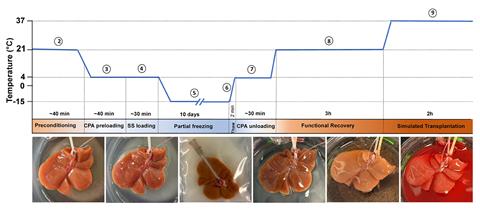
Her Boston-based team used partial freezing to preserve rat livers for up to 10 days at –15ºC. The approach is inspired by the state of suspended animation that wood frogs enter when they hibernate; both rely partly, and perhaps counterintuitively, on ice-promoting molecules to control the freezing process. In the frog, this process still ends in 65% of the water in its body freezing but leaves time for it to be drawn out of cells into the vascular spaces, where it does less damage when it freezes. ‘That’s one of the reasons we call our approach partial freezing,’ says Tessier. ‘Because there’s a fraction that’s trapped as ice, but we also have a fraction that’s unfrozen, and the unfrozen fraction is important because that’s where cells live.’ The team has yet to carry out transplants with their defrosted organs. Compared to long-term storage options, however, it could be easier for such an approach to overcome the necessary regulatory hurdles.
Toxicity troubles
It’s not just embryologists and the creators of future organ banks who want to put life on ice, however. All sorts of researchers in the life sciences need to cool, store and then revive different types of cells. In regenerative medicine, these might be stem cells that are being used to develop new cell-based therapies. As materials chemist Kazuaki Matsumura, at the Japan Advanced Institute of Science and Technology, explains, researchers in this field are in search of new cryoprotectants to replace DMSO, which has been the standard for decades now. They’re concerned about its toxicity and suggestions that it affects how stem cells differentiate – influencing what cells their stem cells turn out to be. DMSO, glycerol and other small, ‘permeating’ cryoprotectant molecules pass right through cell membranes, so the thinking is that non-permeating molecules that stay on the outside should be less capable of interfering with the internal machinery of the cell that determines its fate.

Matsumura’s group has been trying since 2009 to develop non-permeating polymers called polyampholytes, but progress in optimising the synthetic cryoprotectants has been hindered by struggles with pinning down their mechanisms. ‘In our 2009 paper, we thought that their properties could be similar to the antifreeze proteins, but now I think that’s not actually correct,’ Matsumura says. Recent experiments using NMR spectroscopy probed the behaviour of water, polyampholytes and salts in ice, suggesting the polymers have more in common with molecules that protect certain insects and other animals – including the incredibly resilient tardigrades (‘water bears’) – from damage caused by drying out.
Many natural antifreeze proteins, such as those found in some fish, work by binding to the surface of ice crystals to suppress ice growth and chemists have developed synthetic versions of these to tackle the problem of deadly ice crystallisation during rewarming. Polyampholytes, however, seem to prevent damage caused by excessive dehydration, which can be just as lethal. The polymers all have multiple positive and negative charges, which trap the ions that concentrate outside cells as the external water turns to ice, limiting the amount of water they can draw out. Matsumura’s team is now using this new understanding to design more effective cryoprotectant molecules.
Fuller, though, says DMSO is so routinely used that he can’t see it being ousted completely, at least for the next decade. And, meanwhile, cryopreservation faces other challenges – like the engineering ones of super-fast cooling and warming at scale. It seems the puzzle of putting life on ice will occupy another generation of scientists, all inching towards a solution to this complex problem. ‘All of the challenges remain the same,’ says Fuller. ‘The basis of it is what happens to cells when they’re exposed to very low temperatures in a very dehydrated space, because the water’s gone to ice.’
Hayley Bennett is a science writer based in Bristol, UK
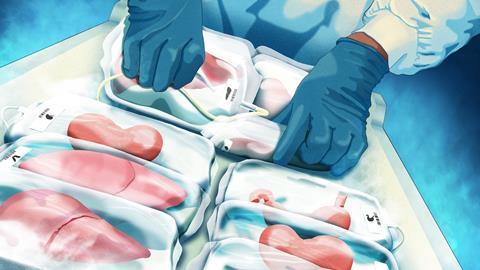



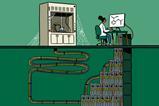


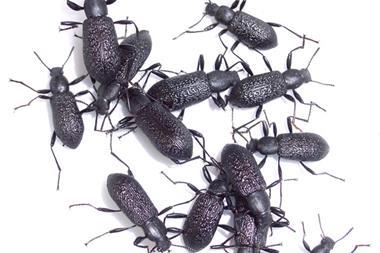
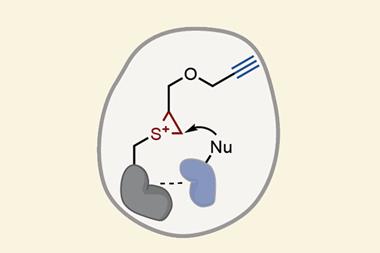
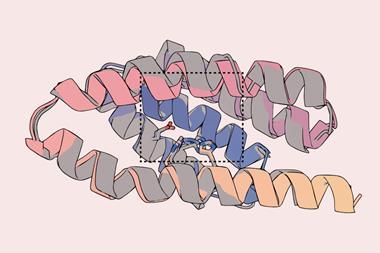
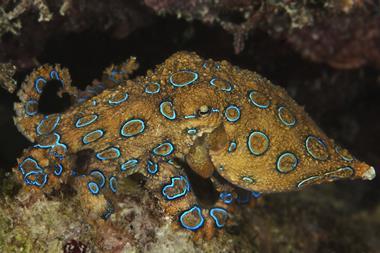


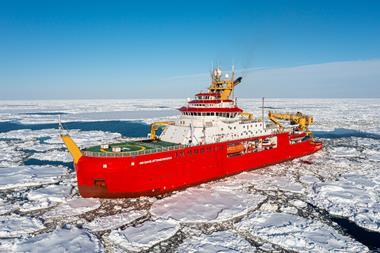

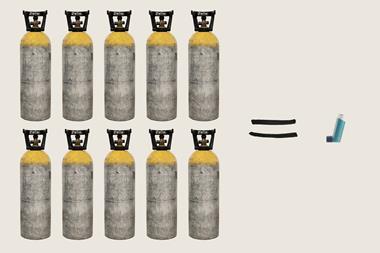

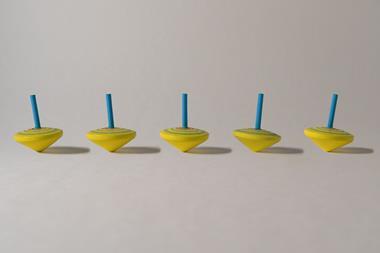
No comments yet